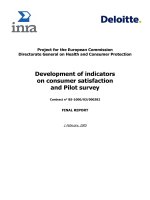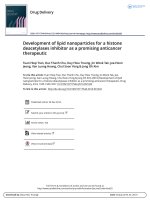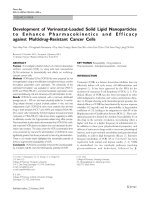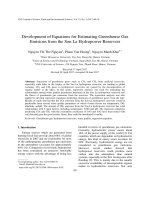DEVELOPMENT OF CORRONSION RESISTANT STEEL FOR BOTTOM PLATE OF COT
Bạn đang xem bản rút gọn của tài liệu. Xem và tải ngay bản đầy đủ của tài liệu tại đây (203.43 KB, 4 trang )
Shipbuilding Technology ISST 2007, Osaka, 2007
DEVELOPMENT OF CORROSION RESISTANT STEEL FOR BOTTOM PLATE OF COT
Y Inohara, JFE steel corporation, Japan
T Komori, JFE steel corporation, Japan
K Kyono, JFE steel corporation, Japan
K Ueda, JFE steel corporation, Japan
S Suzuki, JFE steel corporation, Japan
H Shiomi, JFE steel corporation, Japan
SUMMARY
Recently, the corrosion problem in the ship is paid to attention. Especially, the pitting corrosion occurred on the inner
bottom plate of COT (Cargo Oil Tank) of crude oil tanker to need the inspection and the repair of every dock is one of
the big problems. The inner bottom plate is being covered with the ‘oil-coat’ that is the crude oil element and protected
from corrosion. But, the pitting corrosion occurs, and grows up by the ‘oil-coat’ defect part become a local anode site.
This phenomenon was reproduced in the laboratory, and the laboratory pitting corrosion test method was established.
And the pitting corrosion decrease effect of the zinc-primer on which it reported before is used, the low alloy corrosion
resistant steel to which the number of pitting corrosion was greatly decreased by using it together with the zinc-primer
was developed. When this corrosion resistant steel is applied to a tanker, the number of pitting corrosion for which the
repair at the dock is necessary can be decreased sharply at a low level. ¶
1.
from crude oil. In addition, it is presumed that the
elements of ‘inert gas’ and H2S volatilized in crude oil
merge in this salt water. This environment is very severe
for corrosion of conventional steel [1].
INTRODUCTION
Recently, the corrosion problem in the ship is paid to
attention. Especially, the pitting corrosion occurred on
the inner bottom plate of COT (Cargo Oil Tank) of crude
oil tanker to need the inspection and the repair of every
dock is one of the big problems.
In Japan, for three years from 1999, field examination
was carried out to make the corrosion phenomenon of
COT of cargo oil tanker clear. As a result, the actual
corrosion environments in COT were clarified. Because
of the investigation result, it was presumed that the
pitting corrosion on the inner bottom plate occurred and
grew up under the environment not uniform, such as a
defect of ‘oil coat’, localized salt water or etc., and
existence of oxidizer, such as iron oxide, iron sulfide,
elemental sulfur or etc [1].
This phenomenon was reproduced in the laboratory, and
the laboratory pitting corrosion test method was
established. And the pitting corrosion decrease effect of
the zinc-primer on which it reported before is used, the
low alloy corrosion resistant steel to which the number of
pitting corrosion was greatly decreased by using it
together with the zinc-primer was developed.
2.
PITTING CORROSION
2.1
ACTUAL ENVIRONMENT
Ex. : 13%CO2, 5%O2, 5%H2O,
0.2%H2S, 0.01%SOx, Bal. N2
Vapor space
Crude oil
Salt water
Sludge
Oil coat
Figure 1: Cross section of crude oil tanker.
2.2
MECHANISM OF PITTING CORROSION
GENERATION AND GROWTH
Usually, the inner bottom plate covered with ‘oil coat’
has corrosion protection. However, piling up of the
‘sludge’, COW (Crude Oil Washing) and etc. cause the
defect of ‘oil coat’. If the low protective point such as the
defect of ‘oil coat’ occurs on the inner bottom plate, the
pitting corrosion is generated in this point. In the salt
water, the low protective point becomes anode site, the
‘oil coat’ and the ‘sludge’ become cathode site. In this
area, macro-cell is formed and pitting corrosion grows up
[1].
As a result of field examination, it was presumed that the
‘sludge’ is piling up various solid such as solid in the
crude oil, iron rust and sulfur generated in COT and etc.
Figure 2 shows the image of pitting corrosion growth.
Figure 1 shows the cross section of the crude oil tanker.
In operation, the gas part of COT is always filled with
‘inert gas’ for the explosion-proof. ‘Inert gas’ is the
exhaust gas of the low oxygen concentration. It is
composed of CO2, O2, SO2, N2 and etc. The inner bottom
plate surface of COT was covered with ‘oil coat’
composed of heavy ingredients of crude oil, piled up
‘sludge’ composed of rust and solid in crude oil, and
collected the high concentration salt water separated
© 2007: JASNAOE-RINA
H2S
33
Shipbuilding Technology ISST 2007, Osaka, 2007
Gas (Simulated inert gas + H2S)
Pitting (anode)
Salt water (10%NaCl)
Sludge (cathode)
Specimen
Oil coat
Seawater
Oil coat
(313K)
Steel plate
Figure 3: Simulated pitting corrosion test for COT.
Figure 2: Image of pitting growth.
4.
CHARACTTERISTICS OF DEVELOPED
STEEL
3.
PITTING CORROSION TEST METHOD
4.1
EFFECT OF DECREASE OF PITTING
CORROSION OF ZINC-PRIMER
Figure 3 shows the laboratory pitting corrosion test
method. Test solution was 10% NaCl solution, and it was
saturated with 13%CO2-5%O2-0.01%SO2-0.2%H2Sbal.N2 gas. The temperature of the solution was
maintained 313K with a double cell. Specimen size was
75 x 50 x 4 millimeters. Surface of specimen was
covered with the seal tape expect one test surface. Test
surface of specimen was coated with the crude oil residue
gathered from COT, and at the center of test surface, no
coated area (diameter: 5mm) imitated the defect of oil
coat’ was made. The specimens were soaked upward in
the solution. After these specimens were soaked from 28
for 36 days, the shape of the pitting corrosion that
occurred on the surface was measured, and each
specimen was evaluated by each maximum pitting
corrosion depth. The shape (ratio of average diameter
and depth) of the pitting corrosion that occurred by this
test was corresponding to the shape of the pitting
corrosion observed on the inner bottom plate of COT
well.
© 2007: JASNAOE-RINA
As a result of field examination, the number of pitting
corrosion occurred on the inner bottom painted zincprimer was clearly lower than the number of pitting
corrosion occurred on the non-painted inner bottom plate.
In the first dock, the number of pitting corrosion
occurred on the inner bottom painted zinc-primer was
from one-fifteenth to one-thirtieth as compared with the
number of pitting corrosion occurred on the non-painted
inner bottom plate. Various addition elements that
strengthened the effect of the zinc-primer of the pitting
corrosion decrease were examined, and the corrosion
resistant steel was developed.
4.2
PITTING CORROSION RESISTANCE
The zinc-primer painted specimen of conventional steel
and that of developed steel were prepared, and they were
evaluated by the above-mentioned pitting corrosion test
method. Figure 4 shows the result of pitting corrosion
test. The maximum pitting corrosion depth of the
developed steel decreased by about 35% compared with
that of conventional steel.
When this result is applied to the distribution of the depth
of the pitting corrosion measured by field examination of
the zinc-primer specification tanker, the number of
pitting corrosion in need of repair of developed steel that
painted the zinc-primer is provisionally calculated that it
is possible to decrease to one third or less of the
conventional steel painted the zinc-primer.
34
Shipbuilding Technology ISST 2007, Osaka, 2007
Table 2: Mechanical properties of welded joint.
Charpy
Impact Test
TS
at 273K
Grade
(N/mm2)
Notch
Energy
position
(J)
WM
106
Developed steel
FL
149
515
HAZ
1mm
247
(FCB welding method,
HAZ 3mm 273
Heat input: 108(kJ/cm))
HAZ 5mm 317
IACS, 32D
> 440
> 34
1.5
Max. Pitting Depth (mm)
with Zinc-primer, Test period: 36days
1.0
a decrease of
about 35%
0.5
0.0
Conventional Steel
Developed Steel
Figure 4: Maximum pitting depth of conventional steel
and developed steel.
4.3
5.
• The pitting corrosion test method that was able to
simulate the pitting corrosion that occurred on the
inner bottom plate of COT was established.
• The corrosion resistant steel that strengthened the
effect of the zinc-primer of the pitting corrosion
decrease was developed. The maximum pitting
corrosion depth has decreased by about 35%
compared with conventional steel.
• The developed steel has mechanical properties and
construction performance equal with conventional
steel as steel plate for shipbuilding.
MECHANICAL PROPERTIES
Table 1 shows an example of the typical mechanical
properties of base metal of the developed steel. The
developed steel was satisfied with the specification of
32D grade of IACS. Table 2 shows the results of tensile
test and Charpy V notch impact test of the welded joint
of the developed steel. The welded joint of the developed
steel was satisfied with the specification of 32D grade of
IACS, too. The mechanical properties of developed steel
are equal to them of conventional steel, and in building
of the tanker, the welding and construction performance
similar to conventional steel are usually possible.
6.
REFERENCES
1. Ship Research Panel 242, ‘Study on Cargo Oil Tank
Corrosion of Oil Tanker’, Ship Research Summary
Report No.431, Tokyo, JSRA, 2002
Table 1: Mechanical properties of developed steel.
Charpy
Impact
YS
TS
EL
Test
Grade
(N/mm2) (N/mm2) (%)
at 253K
Energy (J)
Developed
399
485
31
326
steel
IACS, 32D
> 315
440/590 > 18
> 31
© 2007: JASNAOE-RINA
CONCLUSIONS
7.
AUTHORS’ BIOGRAPHIES
Yasuto Inohara holds the current position of senior
researcher at Corrosion Protection Research Department,
Steel Research Laboratory, JFE Steel Corporation. He is
responsible for development of corrosion resistant steel.
35
Shipbuilding Technology ISST 2007, Osaka, 2007
© 2007: JASNAOE-RINA
36









